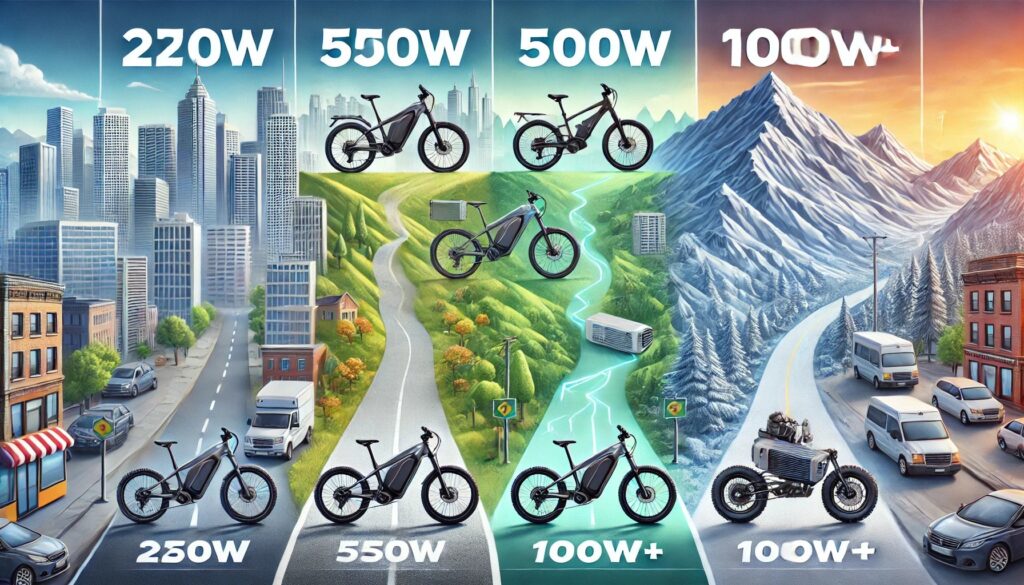Electric bikes (e-bikes) are transforming the way we commute, explore, and enjoy the outdoors. One of the most crucial decisions when choosing an e-bike is selecting the right E-Bike Motor Power. Should you go with a 250W, 500W, or even a 1000W+ motor? The answer depends on several factors, including terrain, riding style, and legal restrictions.
In this guide, we’ll break down the differences in E-Bike motor wattage, discuss performance considerations, and help you find the best motor power for your needs.
1. Understanding E-Bike Motor Wattage

What Is E-Bike Motor Wattage?
E-bike motors are rated by watts (W), which indicate their power output. In simple terms, a higher wattage motor delivers more power, allowing for greater speed and torque.
However, more power isn’t always better. A higher-wattage motor drains the battery faster and may not be legal in all areas. Understanding the balance between power and efficiency is key to making the right choice.
Why Wattage Matters
- Determines how well the bike handles inclines.
- Affects acceleration and top speed.
- Impacts battery life and range.
- Dictates legal road use in certain regions.
2. Key Factors to Consider When Choosing Motor Power
Pedal Assist vs. Throttle
E-bikes typically come with either pedal assist (where the motor helps as you pedal) or throttle control (where the motor propels the bike without pedaling). Higher wattage motors provide stronger throttle performance but consume more battery.
E-Bike Torque and Speed
Torque affects how quickly your bike accelerates and how well it climbs hills. Higher wattage motors usually produce more torque, making them ideal for hilly terrain and off-road use.
Battery Life and Motor Efficiency
A 1000W motor will deplete your battery much faster than a 250W motor. If long-distance riding is a priority, a lower wattage motor may be the better choice.
Legal E-Bike Motor Limits
Many countries and states regulate E-Bike motor performance. For example:
- Europe: 250W is the maximum legal limit for road use.
- U.S.: Federal law allows up to 750W, but state regulations vary.
- Canada: 500W is the legal limit for most provinces.
Before purchasing an e-bike, check local laws to ensure compliance.
3. Comparing 250W, 500W, and 1000W+ Motors
250W E-Bike Motor
✅ Best for city commuting and flat terrain. ✅ Lightweight, energy-efficient, and longer battery life. ✅ Legal in most countries. ❌ Struggles with steep hills and heavier riders.
Ideal for: Casual riders, urban commuters, and those looking for an eco-friendly alternative to cars.
500W E-Bike Motor
✅ A balance between power and efficiency. ✅ Handles moderate hills and light off-road terrain. ✅ Faster acceleration than a 250W motor. ❌ May not be legal in some regions.
Ideal for: Mixed-terrain riders, moderate commuters, and those needing more power without excessive battery drain.
1000W+ E-Bike Motor
✅ High torque for steep hills and off-road adventures. ✅ Faster speeds, often exceeding 28 mph. ✅ Great for heavy riders or carrying cargo. ❌ Drains battery quickly and may not be street-legal.
Ideal for: Adventure riders, hilly areas, and off-road enthusiasts.
4. Hub Motor vs. Mid-Drive Motor: Which is Better?
- Hub Motor: Common in budget-friendly e-bikes, located in the wheel hub. Best for flat terrain and casual riding.
- Mid-Drive Motor: Positioned at the bike’s crankset, offering better torque and balance. Ideal for hills and off-road use.
If you prioritize efficiency and balance, a mid-drive motor is a better option. However, hub motors are simpler and require less maintenance.
5. Best E-Bike Motor Power for Different Use Cases
E-Bike Commuting Power
For city commuting, a 250W or 500W motor is ideal. They offer sufficient speed while maximizing battery life.
Off-Road vs. City E-Bikes
If you plan on tackling dirt trails and steep hills, go for a 1000W+ motor. For smooth pavement, a 250W or 500W motor is more than enough.
Long-Distance Riding
A lower wattage motor (250W-500W) extends battery range, making it a great option for long-distance riders.
6. Final Thoughts: Choosing the Right Motor Power
Selecting the right E-Bike Motor Power depends on your riding style, terrain, and local laws. Here’s a quick recap:
- 250W: Best for city commutes and flat roads.
- 500W: A middle-ground option for mixed terrain.
- 1000W+: Ideal for off-road adventures and steep hills.
Before buying an e-bike, consider testing different motor wattages or consulting a specialist to ensure the best fit for your needs. Whether you’re riding for fun, fitness, or commuting, the right motor power will make all the difference!
What’s Next?
Now that you know the differences, which e-bike motor suits your needs? Let us know in the comments or check out some of the latest e-bike models available today!








